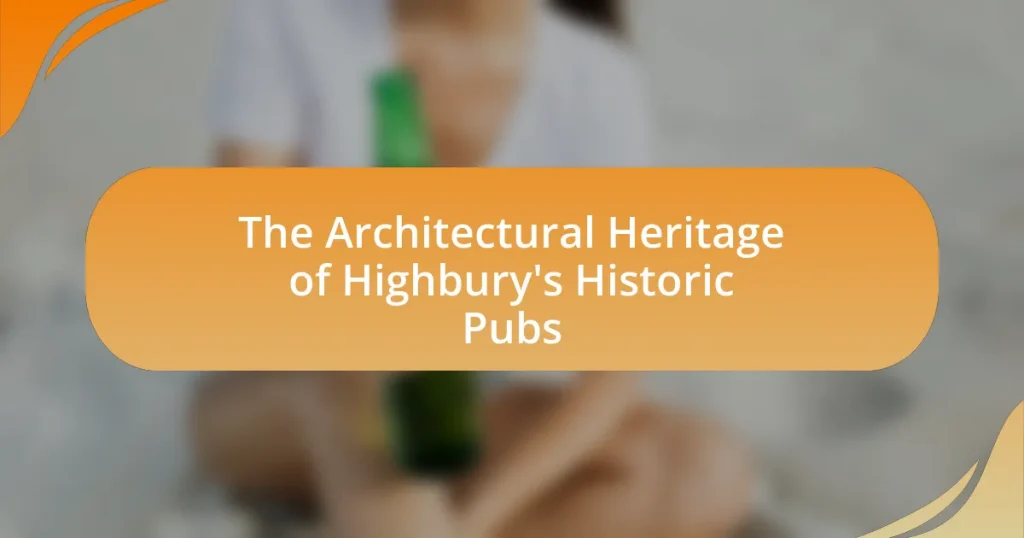The architectural heritage of Highbury’s historic pubs is characterized by Victorian and Edwardian designs, featuring ornate facades, intricate brickwork, and decorative elements that reflect the area’s social and cultural history. Historical events, such as the Industrial Revolution and World War II, have influenced the architectural styles and functionality of these pubs, which serve as community hubs. The preservation of these structures is vital for maintaining local identity and heritage, supported by regulations that protect their historical significance. The article explores the architectural features, cultural importance, and contemporary challenges facing these historic pubs, emphasizing the need for community engagement and effective navigation of preservation regulations to ensure their longevity.
What defines the architectural heritage of Highbury’s historic pubs?
The architectural heritage of Highbury’s historic pubs is defined by their Victorian and Edwardian designs, characterized by ornate facades, intricate brickwork, and decorative elements such as stained glass and wrought iron. These architectural features reflect the social and cultural history of the area, with many pubs serving as community hubs since the 19th century. The preservation of these structures is supported by local heritage listings, which recognize their significance in representing the architectural styles and urban development of Highbury during that period.
How have historical events influenced the architecture of these pubs?
Historical events have significantly influenced the architecture of Highbury’s historic pubs by shaping their design, materials, and functionality. For instance, the Industrial Revolution led to the construction of larger, more robust structures to accommodate the growing working-class population, resulting in pubs with expansive interiors and distinctive facades. Additionally, the Victorian era introduced ornate detailing and decorative elements, reflecting the era’s architectural trends, as seen in pubs built during that time, which often featured intricate brickwork and stained glass. Furthermore, the impact of World War II prompted many pubs to adopt a more utilitarian design due to resource shortages, leading to simpler, functional layouts. These architectural adaptations illustrate how historical events have directly shaped the physical characteristics and cultural significance of Highbury’s pubs.
What architectural styles are prevalent in Highbury’s historic pubs?
Highbury’s historic pubs predominantly feature Victorian and Edwardian architectural styles. These styles are characterized by ornate detailing, brick facades, and large windows, reflecting the design trends of their respective periods. Many of these pubs were built during the late 19th and early 20th centuries, showcasing elements such as decorative tiles, intricate woodwork, and high ceilings, which are hallmarks of Victorian architecture. Edwardian pubs often exhibit a more simplified aesthetic but still retain decorative features, emphasizing craftsmanship and quality materials. The prevalence of these styles in Highbury’s pubs highlights the area’s rich architectural heritage and historical significance.
How do local materials contribute to the architectural identity of these pubs?
Local materials significantly contribute to the architectural identity of Highbury’s historic pubs by reflecting the region’s cultural heritage and craftsmanship. The use of locally sourced stone, brick, and timber not only enhances the aesthetic appeal but also establishes a sense of place, connecting the buildings to their geographical context. For instance, pubs constructed with local red brick often showcase traditional building techniques that have been passed down through generations, reinforcing community identity. Additionally, these materials can provide insights into the historical availability of resources, as seen in the prevalence of specific types of stone in certain areas, which further anchors the pubs within their local history.
Why is the preservation of these pubs important?
The preservation of these pubs is important because they serve as vital cultural and historical landmarks that reflect the social fabric of the community. Highbury’s historic pubs embody architectural styles and local traditions that contribute to the area’s identity, offering a tangible connection to its past. For instance, many of these establishments date back to the 19th century, showcasing unique designs and craftsmanship that are increasingly rare. Their preservation helps maintain the character of Highbury, supports local economies through tourism, and fosters community engagement by providing spaces for social interaction.
What cultural significance do Highbury’s historic pubs hold for the community?
Highbury’s historic pubs serve as vital cultural hubs for the community, fostering social interaction and preserving local heritage. These establishments often reflect the architectural styles and historical narratives of the area, contributing to a sense of identity among residents. For instance, many of these pubs have been in operation for over a century, showcasing traditional designs and craftsmanship that highlight the neighborhood’s evolution. Their role extends beyond mere dining and drinking; they host community events, support local artists, and provide a space for residents to engage in cultural dialogues, thereby reinforcing community bonds and continuity.
How do these pubs reflect the social history of Highbury?
The pubs in Highbury reflect the social history of the area by serving as communal gathering spaces that have evolved alongside the neighborhood’s demographic changes. Historically, these establishments have been central to local social life, providing a venue for community interaction, celebration, and political discourse. For instance, the presence of pubs dating back to the Victorian era illustrates the working-class roots of Highbury, while more recent establishments highlight the gentrification and influx of diverse populations. Additionally, the architectural styles of these pubs, ranging from traditional to modern designs, mirror the socio-economic shifts and cultural transformations within Highbury, showcasing how these venues adapt to the changing needs and identities of their patrons.
What are the key features of Highbury’s historic pubs?
Highbury’s historic pubs are characterized by their Victorian architecture, traditional interiors, and unique historical significance. Many of these pubs feature ornate facades with decorative brickwork, large bay windows, and intricate signage that reflect the architectural styles of the 19th century. Inside, the pubs often retain original features such as wooden bar counters, stained glass windows, and period furnishings, creating an authentic atmosphere. Additionally, several of these establishments have historical connections to local events or figures, enhancing their cultural importance within the community. For instance, the iconic “The Black Horse” dates back to the 1800s and showcases classic pub design elements that have been preserved over time.
What architectural elements are commonly found in these pubs?
Common architectural elements found in Highbury’s historic pubs include ornate facades, large bay windows, decorative cornices, and timber framing. These features reflect the Victorian and Edwardian architectural styles prevalent during the late 19th and early 20th centuries. For instance, many pubs showcase intricate brickwork and stone detailing, which are characteristic of the period’s craftsmanship. Additionally, stained glass windows often adorn entrances, enhancing the aesthetic appeal and historical significance of these establishments.
How do decorative features enhance the aesthetic appeal of these pubs?
Decorative features significantly enhance the aesthetic appeal of Highbury’s historic pubs by adding visual interest and character. These elements, such as intricate moldings, stained glass windows, and ornate signage, create a unique atmosphere that attracts patrons and reflects the historical context of the establishment. For instance, the use of traditional materials like brick and wood in decorative facades not only showcases craftsmanship but also connects the pub to its architectural heritage, making it a landmark within the community. Additionally, studies have shown that well-designed decorative elements can increase customer satisfaction and encourage longer visits, thereby boosting the pub’s overall appeal and profitability.
What role do outdoor spaces play in the design of Highbury’s pubs?
Outdoor spaces are integral to the design of Highbury’s pubs, enhancing social interaction and community engagement. These outdoor areas provide patrons with an inviting environment to enjoy drinks and meals, often featuring gardens, terraces, or patios that reflect the local architectural style. Historical evidence shows that many pubs in Highbury have incorporated outdoor spaces to accommodate the growing demand for al fresco dining and drinking, particularly during warmer months. This design choice not only increases the capacity of the pubs but also fosters a vibrant atmosphere that attracts both locals and visitors, contributing to the cultural fabric of the area.
How do renovations impact the architectural integrity of these pubs?
Renovations can significantly impact the architectural integrity of Highbury’s historic pubs by altering original design elements and materials. When renovations involve modern materials or techniques that differ from the traditional construction methods, they can compromise the authenticity and historical value of the structure. For instance, replacing original timber beams with steel supports may enhance structural stability but detracts from the building’s historical character. Furthermore, changes to facades, such as the addition of contemporary signage or alterations to window styles, can disrupt the visual coherence of the pub’s architectural style, which is often rooted in specific historical periods. Preservation guidelines, such as those outlined by the National Trust, emphasize the importance of maintaining original features to uphold the architectural integrity of historic buildings, underscoring that sensitive renovations should prioritize restoration over replacement to protect the cultural heritage of these pubs.
What challenges do owners face when restoring historic pubs?
Owners face several challenges when restoring historic pubs, including compliance with preservation regulations, financial constraints, and the need for specialized craftsmanship. Preservation regulations often require owners to adhere to strict guidelines that protect the building’s historical integrity, which can limit renovation options and increase costs. Financial constraints arise from the high expenses associated with sourcing authentic materials and hiring skilled artisans familiar with traditional construction techniques. Additionally, owners may encounter structural issues that require extensive repairs, further complicating the restoration process. These challenges are compounded by the need to balance modern amenities with historical authenticity, making the restoration of historic pubs a complex endeavor.
How can renovations respect the original architectural style?
Renovations can respect the original architectural style by adhering to the historical design elements, materials, and craftsmanship that define the structure. This approach involves conducting thorough research on the building’s history and architectural significance, ensuring that any updates or modifications align with the original aesthetic. For instance, using period-appropriate materials, such as traditional brick or wood, and maintaining original features like moldings, windows, and doors can preserve the character of the building. Historical preservation guidelines, such as those from the National Park Service, emphasize the importance of retaining distinctive architectural features to maintain the integrity of historic structures.
What are the contemporary challenges facing Highbury’s historic pubs?
Highbury’s historic pubs face several contemporary challenges, primarily including rising operational costs, changing consumer preferences, and competition from modern establishments. Rising operational costs, such as increased rent and utility expenses, threaten the financial viability of these pubs, many of which are located in gentrifying areas. Changing consumer preferences, particularly the shift towards craft beers and alternative drinking venues, have led to a decline in traditional pub patronage. Additionally, competition from modern bars and restaurants that offer diverse experiences further exacerbates the struggle for historic pubs to attract and retain customers. These factors collectively jeopardize the preservation of Highbury’s architectural heritage, as many historic pubs may be forced to close or undergo significant alterations to remain profitable.
How does urban development affect the preservation of these pubs?
Urban development significantly impacts the preservation of historic pubs by often prioritizing new construction over the conservation of existing structures. As urban areas expand, the demand for space can lead to the demolition or alteration of historic pubs, which are integral to local culture and heritage. For instance, in Highbury, the pressure from real estate development has resulted in the loss of several historic pubs, as developers seek to replace them with modern housing or commercial spaces. This trend is supported by studies indicating that urbanization frequently undermines the architectural integrity of heritage sites, as seen in various cities where historic pubs have been sacrificed for new developments.
What measures are being taken to protect Highbury’s historic pubs from redevelopment?
Highbury’s historic pubs are being protected from redevelopment through various measures, including listing as Assets of Community Value (ACVs) and conservation area designations. These designations help safeguard the pubs by requiring developers to demonstrate that the community would not be adversely affected by any proposed changes. Additionally, local councils are implementing stricter planning regulations to ensure that any alterations respect the architectural heritage and historical significance of these establishments.
How can the community support the preservation of these pubs?
The community can support the preservation of Highbury’s historic pubs by actively participating in local initiatives aimed at heritage conservation. Engaging in campaigns to raise awareness about the cultural significance of these establishments can mobilize public support and encourage local government action. For instance, community-led fundraising events can generate financial resources necessary for restoration projects, while petitions can influence policy decisions regarding heritage protection. Historical data shows that communities that advocate for their local heritage often see increased tourism and economic benefits, reinforcing the importance of preserving these pubs as vital components of local identity and history.
What role do local regulations play in the preservation of historic pubs?
Local regulations are crucial in the preservation of historic pubs as they establish legal frameworks that protect these buildings from inappropriate alterations and demolitions. These regulations often include listing or designation as heritage assets, which restricts changes that could compromise their historical and architectural significance. For instance, in the UK, the Planning (Listed Buildings and Conservation Areas) Act 1990 mandates that any alterations to listed buildings require special permission, ensuring that the unique character of historic pubs is maintained. Additionally, local councils may implement conservation area policies that promote the preservation of the overall aesthetic and cultural heritage of neighborhoods, further safeguarding historic pubs from modern developments that could detract from their historical value.
What are the key regulations that protect Highbury’s historic pubs?
The key regulations that protect Highbury’s historic pubs include the Planning (Listed Buildings and Conservation Areas) Act 1990, which provides legal protection for listed buildings, and local conservation area designations that impose restrictions on alterations and developments. These regulations ensure that any changes to the historic pubs must preserve their architectural and historical significance, as evidenced by the designation of several pubs in Highbury as Grade II listed buildings, which highlights their importance to the local heritage.
How can pub owners navigate these regulations effectively?
Pub owners can navigate regulations effectively by staying informed about local laws, engaging with regulatory bodies, and implementing best practices for compliance. Regularly reviewing updates from local councils and heritage organizations ensures that pub owners are aware of any changes in regulations that affect their establishments. Additionally, establishing open communication with local authorities can facilitate guidance and support in meeting compliance requirements. For instance, participating in workshops or forums hosted by heritage organizations can provide valuable insights into maintaining architectural integrity while adhering to regulations.
What practical steps can be taken to ensure the longevity of Highbury’s historic pubs?
To ensure the longevity of Highbury’s historic pubs, implementing a combination of preservation policies, community engagement, and financial support is essential. Preservation policies can include designating these pubs as heritage sites, which would protect them from inappropriate alterations and ensure their historical significance is maintained. Community engagement can involve local residents in decision-making processes regarding the pubs, fostering a sense of ownership and responsibility towards their upkeep. Financial support can come from grants or subsidies aimed at maintaining the structural integrity and historical features of these establishments, as evidenced by successful initiatives in other regions where similar measures have led to the revitalization of historic pubs.



